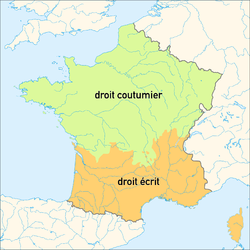User:Liam Lannister/sandbox

In France, the Former Law was the French law in force under the Monarchy of the Ancien Régime, that is to say until the French Revolution, which established a "New Law" (current French law) based on news legislative principles and legal practices.
This Former Law was distinguished into two great ensembles: the north of France applied a customary law, founded on custom and privileges which were often the work of ages; the south of France was subject to Roman law, often codified.
The chronological boundaries of the Former Law are as questionable as those of the Old Regime. Indeed, notwithstanding the legal and social upheaval of the revolutionary years, many customs and jurisprudence were still being applied because of the numerous legal vacuums, Revolutionaries who could not legislate or codify all aspects of the civilian life of the French because of the tumults that the France of the time had. It was not until 1804, with the promulgation of the Napoleonic Code, that the last customary rules and the old jurisprudence still applicable disappeared de facto in favor of a written, codified and general That is to say, uniformly applicable to the whole of France), which the French First Republic had not been able to complete.
However, many provisions of the Civil Code still retain today the principles inherited from ancient customs, but also from Roman law, which remains an important reference in Latin Europe.
